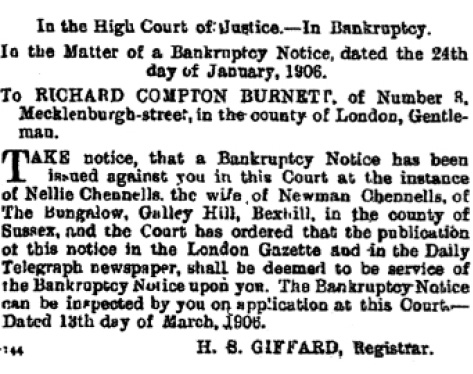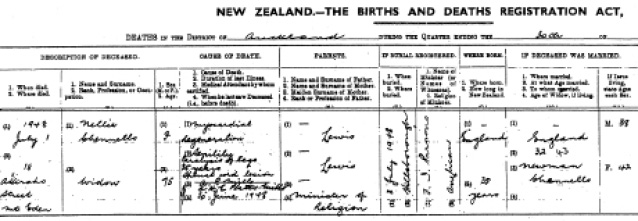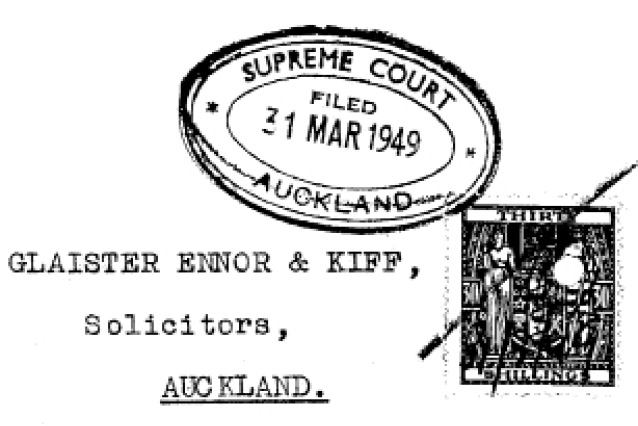On the face of it the last will and testament of Nellie Chennells seemed straight forward, but only if one was not aware of land in England. According to her husband’s will there was land in England so what happened to it?
It will be remembered that Nellie was not named as a beneficiary in her husband’s will nor in any of the probates. We said earlier that her entitlement as his legal wife to his estate was obviously a separate issue.
That separate issue is likely to have been English land she had title to in her own right. Her parents, John Lewis and his wife, came from the same class as the Chennells and it could be assumed that she had also inherited or was receiving income from her homeland through her own parents.
The thought of unspecified land in England keeps niggling away at my mind and whether it still exists today or has been sold, is debatable. My suspicious mind has to presume that it is still cleverly hidden as a secret trust or amongst the gobbledegook of the English system. Lay people try hard to understand it but I am convinced that the answers can be found by reading between the lines.
For several decades I have been chasing shadows, jumping hurdles and being led up the garden path. I’ve taken the high road, been down the low road and everywhere I found road blocks that were impassible. If only I could find the right pathway that this mysterious land takes! I feel this holds an important piece of evidence needed to solve the riddle of who murdered the Crewes.
I now understand a lot better how land registry works in England and while its history is long and complex, it is still extremely difficult to find factual information that points to who is gaining. For obvious reasons I want to know where the money goes from this mysterious land and whether some of it ended up in the hands of the Chennells family.
My thoughts were confirmed when I read a 2011 UK news report that claimed “land registries were designed to conceal ownership, not reveal it” and I did smile at another comment that said: “We need to simplify both land law and the appalling and wholly unnecessary language in which it is dressed up by fee-farming lawyers.” I commiserate as to a lesser extent this also happens in New Zealand.
People in England have been saying for decades that they urgently need clear, simple and logical land registry where all land ownership is recorded with the names of the owners indexed and acreage stated.
TRACING PROPERTY IN ENGLAND
New Zealand’s system of land ownership is reasonably simple to research and to understand so I mistakenly thought it would be just as easy to trace property in England.
Having the addresses of properties where the Chennells family had once lived would surely give me a title that could be searched? Yeah right! Dream on, John!
I eventually found land was almost totally impossible to trace particularly if the property is not registered. In England there was no compulsion for your property to be registered until the last decade when a registration campaign was launched targeting huge landowners who had previously avoided disclosing their assets.
The result of this change was staggering as it discovered that more than a third of Britain’s land is actually owned by a wealthy core of just 1200 aristocrats and their relatives.
And that’s not all. Over the centuries the land-owning class has created vast wealth for itself from its holdings. This wealth has been derived from agriculture, forestry, rents, mining, hunting and sport and since the early part of the 20th century, tourism. It seems they have always pursued their profitable goals against the common interest and at the expense of ordinary people.
I also found that farmers in England, for instance, receive subsidies with most of their assets being held in trust thus avoiding crippling inheritance tax.
This sounds very familiar and I strongly suspect that the Chennells family was right amongst it and were benefiting from an age old system that allowed the wealthy to either secretly hide the land they owned and/or avoid those crippling death duties.
JOINING UP THE DOTS
I am led to believe that Nellie did not benefit from Newman’s will and that has always been a worry. Because things were not adding up, I decided to explore whether I could join up the dots somehow from the addresses where Newman and Nellie had resided over the years and to see if these properties were in wealthy areas.
Newman was born at Melbourne Dale, Cambridgeshire, England in June 1866 but by the age of five the family were living at Bretford, a small hamlet in Warwickshire. Ten years later their address was Woking, a large town on the south-western edge of the Greater London Urban Area.
The earliest address I have found for Nellie Lewis was on her 1898 marriage certificate. Nellie was a spinster aged 25 and lived at 69 Charlotte St while her newly-wedded husband Newman was entered as Parish of Holy Trinity, Hastings.
These areas do suggest wealth with the added information on their marriage certificate confirming both parents, Joseph Chennells and John Lewis, as deceased “gentlemen” meaning they were middle class men above rank and file. The dictionary meaning of “gentleman” is “a man of good social position, especially one of wealth and leisure.”
It was pleasing from my perspective to validate that the parents of both bride and groom were honourable men and while their profession is not stated, the rank or profession of Newman Chennells was entered as “Auctioneer & Estate Agent”. This is a very significant fact considering the family’s later involvement with land in New Zealand. Again, I solemnly believe that issues with land and wealth led eventually to the murders of the Crewes.
But first, more background to the days in their lives while living in England and the connections being made through marriages and involvement of other families.
Just how wealthy the Chennells and Lewis families were cannot be established with surety but the gut feeling cannot be discounted or ignored. “Where there’s smoke, there’s fire” is the theory I am presently following.
LINKS SUGGESTING WEALTH
The Chennells/Lewis marriage certificate also reveals other links suggesting wealth. Their marriage was solemnised at Trinity Church in the Parish of Marylebone in the County of London. This Anglican Church was built in 1828 from money provided to celebrate the defeat of Napoleon. Sadly it fell into disuse by the 1930s and in 1936 was used by the newly founded Penguin Books company to store books.
On the other hand, Newman’s address was given as the Parish of Holy Trinity, Hastings, a “beautiful church of Holy Trinity in the town centre of Hastings, in the South East corner of England, has welcomed worshippers for 150 years.”
The history of Hastings itself stretches back to the 10th century and as every schoolboy knows was associated with the Battle of Hastings in 1066. At that time it was “a little market town” but by 1901 the population had risen to 65,528 making it by New Zealand standards a large city.
In moving to the 1901 census of England I found the Chennells were recorded as living in the County of Sussex but no street address was given. However, a bankruptcy notice of 1906 gave Nellie’s address as The Bungalow, Gallery Hill, Bexhill, Sussex.
Bexhill was a favourable area for the well to do or more refined. Lodgings there cost money and being a close neighbouring town to Hastings, the wealth of Bexhill is not questioned.
We found the bankruptcy notice to be of more than a passing interest. Why was Nellie issuing a bankruptcy notice against Richard Compton Burnett? I’m given to understand that Burnett left England soon after the bankruptcy charges. There will be some truth in that rumour. My efforts to find more about the type of businesses in the Mecklenburgh St (close to the King’s Cross area of Central London) drew a blank.
HEALTH OF NELLIE CHENNELLS
There may be a connection with Nellie’s health as those who knew her have said she was crippled from the waist down and while family legend has an answer for her condition, my suspicious mind is pondering on a couple of coincidences.
The bankruptcy notice (above) was dated 24 January 1906 and could be inspected from 13 March 1906. One coincidence is that all this is happening as Nellie was giving birth to her first child. Her daughter, Constance May (Maisie) was born on 1 March 1906 at St Leonards-on-Sea (part of Hastings) and not far from Central London as the crow flies.
Like other assumptions in this very involved saga, I could get egg on my face if I’m totally off beam here, but I have a theory. There may be nothing to it but nobody can blame me for trying to unravel the next minefield and once again the facts are rather thin on the ground.
ARRIVAL IN NEW ZEALAND?
This time I’m trying to work out when Newman and Nellie actually arrived in New Zealand and why they came out at different times. To complete this short period of time I’m also keen to establish when Howard was born and where and how Nellie ended up being crippled.
This is a big ask so I’ll start with the birth of their son Howard Geofrey. There appears to be no birth certificate anywhere. He was born “about 1911”. Nellie’s death certificate of July 1948 said she had a male issue aged 38 which means he was born in 1910. Howard’s gravestone is inscribed with his death date as 21 May 1950, aged 39 which computes to a birth year of 1911.
Death certificates are renowned for their inaccuracy so I feel quite safe in saying Howard was born either near the end of 1910 or early 1911.
The next interesting fact is revealed when the name of Newman Chennells was found on the 1911 Auckland West electoral roll. The general election was held in December so allowing for time to register, Newman would have had to arrive no later than mid 1911 to get on the roll. To achieve this he would have needed to leave England around March or April as the voyage by sea took around 100 days depending on the weather.
This rather tight timetable meant he left shortly after the birth of his son Howard unless, of course, his birth date was in 1910 rather than early 1911 which would give him extra time.
WAS NELLIE FIT TO TRAVEL?
Obviously Nellie was not fit to travel with such a young family so her departure must have happened much later but how much later?
According to her death certificate Nellie died on 1 July 1948 aged 75 with the duration of her last illness entered as 35 years. She had also resided in New Zealand for 35 years. These dates and years indicates she arrived during 1913 and if true would mean she was already a cripple when she arrived in New Zealand.
Family folklore says Nellie was around 36 years of age when she was partly crushed in the pelvic area in a road accident and was paralysed from the waist down losing the use of her legs.
From her age the accident could have definitely occurred in England within the short period after her youngest child was born and when the family arrived in New Zealand (1910 to 1913, give or take a bit).
This raises another question for my sceptical mind that her ‘accident’ may have been caused by medical misadventure such as an epidural which is known to cause a loss of sensation below the waist especially during childbirth.
I really don’t know the answer but whatever happened, these events were not the best time for her husband to be on the other side of the world.
The other factor to bear in mind is the young age of her children at this time–Howard was probably aged around one or two years and around five or six for Maisie.
I strongly feel that continuing with Nellie’s profile will reveal more about her character, her advisors and her financial background particularly giving her lack of money worries.






Leave a Reply